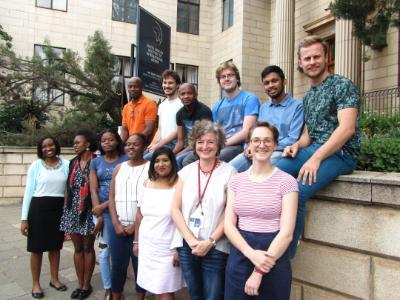The Plant Biotechnology Programme
The Plant Biotechnology Programme
Background: Cassava in the Southern and Eastern African context
Cassava (Manihot esculenta) is the fourth most important food crop in the sub-tropical regions of the world. Cassava is currently grown in South Africa (SA) as a food security crop by subsistence farmers and also commercially for starch from the tubers. The potential for biofuels is also realized. Cassava mosaic disease (CMD) is endemic in SA and several geminivirus species, SACMV, ACMV and EACMV have been reported in SA. South African cassava mosaic virus (SACMV) was first described in 1997 in SA and has since been discovered in Zimbabwe and Madagascar. The loss of yield due to cassava-infecting begomoviruses poses a serious threat to cultivation.
Previous Research
Earlier studies in our laboratory were involved in studying the biodiversity, evolution and epidemiology of cassava begomoviruses and whitefly vectors in southern Africa. Our laboratory was also engaged in research to improve cassava germplasm with regards to CMD resistance and higher starch content using genetic engineering. We successfully engineered transgenic cassava demonstrating higher resistance to cassava mosaic disease or higher starch levels in the tubers. Our sponsors for this research were multiple, but included the Technical Innovation Agency, National Research Foundation and Casquip Cassava Starch Manufacturing Company. Our cassava research led us to collaborations with countries such as Switzerland, Belgium, Mozambique, Tanzania, Nigeria and Uganda in developing cassava for the southern African region, and building capacity for cassava transformation for desired traits.
More Recent and Current Research Objectives
More recent studies, funded by the NRF Blue Skies Programme, have focussed on the molecular responses in the plant host cassava to infection by begomoviruses, in particular South African cassava mosaic virus (SACMV). The focus has been (using DNA microarrays, Illumina or SoLID genome sequencing; small RNA profiling and proteome platforms) to identify genes, transcription factors, hormones, small RNAs and immune hubs, involved in tolerance to CMD in cassava. A particular focus was also on the structure and function of the cell-to-cell movement protein of SACMV, and other cassava host proteins involved in movement of the virus.
Molecular mechanisms involved in susceptible host-virus interactions in other model plant systems such as Arabidopsis thaliana and Nicotiana. benthamiana were also investigated.
Validation of potential candidate genes for CMD resistance through virus induced gene silencing (VIGS) or CRISPR gene editing in protoplasts and in planta was undertaken, and is ongoing.
The derived information could be applied in future to:
- Develop disease resistance by gene editing/genetic engineering.
- Develop potential genes as markers for disease identification
Our most recent focus has been on identification, structural analyses and function of cassava mosaic disease resistance (R) genes, and associated quantitative trait loci genes involved in effector (ETI), and pathogen triggered immunity (PTI) to CMD. In this regard we were awarded a European Union Research & Innovation Partnership grant (LEAP –AGRI) (2019-2022) with Kenya, Belgium and France as other participants.
TOMATO RESEARCH PROGRAMME
Tomato (Solanum lycopersicum or Lycopersicon esculentum) is a herbaceous, dicotyledonous perennial plant which is grown in most countries around the world. Global annual production of tomatoes reached 130 million tons in 2008 (FAOSTAT, 2008). In southern Africa, tomato is considered as one of the most important vegetables along with potatoes and onions. It is grown mainly by subsistence farmers, and the majority of tomato trade in southern Africa, including SA, occurs largely in the informal sector. A third of the total national SA production is supplied by the tomato processing industry. Tomatoes are regularly consumed along with maize meal, which is considered the major staple of southern Africans.
Tomatoes are highly sensitive to attack by a wide variety of pathogens in the field largely due to its cultivation during spring and summer months which favour the growth and transmission of numerous pathogens. These biotic stresses cause mass destruction to tomato plantations leading to substantial economic losses. Control methods such as fungicides, roughing, crop rotations and insecticides have proven to be inefficient in controlling these pathogens. As a result farmers have turned to the use of resistant varieties combined with stringent chemical and heat pre-treatment.
Of particular interest to our plant biotechnology research group is the detection and control of viral pathogens. The novel geminivirus pathogen Tomato curly stunt virus (ToCSV) was discovered in SA and Mozambique. Two variants, mild and severe, were also identified. Our research group conducted research, in collaboration with SAKATA Vegenetics (RSA), the University of Johannesburg, and University of Eduardo Montlane (Mozambique) in the following areas:
- Epidemiology of ToCSV in SA and Mozambique
- Biodiversity of viruses and whitefly vectors in SA and Mozambique
- Role of the the 3’ intergenic region and the V2 protein of two sequence variants (mild and severe phenotypes) of ToCSV in disease pathology in Nicotiana benthamiana and tomato
- The roles of the V2 and C2 genes of Tomato curly stunt virus mild and severe variants in pathogenicity in tomato and Nicotiana benthamiana.
- Identification of new/novel ORFs in ToCSV
CONTACT: Prof. Chrissie Rey 011 717 6324 or 082 499 5790 Chrissie.Rey@wits.ac.za


